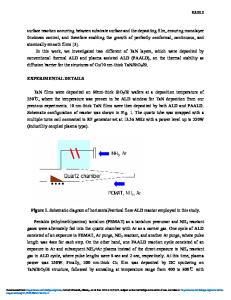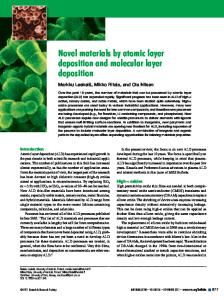Characteristics of copper films produced via atomic layer deposition
- PDF / 166,067 Bytes
- 5 Pages / 612 x 792 pts (letter) Page_size
- 2 Downloads / 425 Views
James McAndrew American Air Liquide, Chicago Research Center, Countryside, Illinois 60525 (Received 22 April 2002; accepted 19 June 2002)
Properties of copper films produced using atomic layer deposition (ALD) were characterized. Composition, morphology, and electrical properties of these films grown on glass, as well as Ta, TiN, and TaN on silicon wafers were examined. The resistivity of films thicker than about 60 nm was near bulk value. Films were deposited using a two-step ALD process in which copper(II)-1,1,1,5,5,5,-hexafluoroacetylacetonate hydrate and water vapor were introduced in the first step and a reducing agent was introduced in a subsequent step. Five reducing agents were evaluated, with the best results obtained using isopropanol or formalin. The optimum deposition temperature with isopropanol was about 260 °C, whereas it was about 300 °C with formalin. These films were also investigated as seed layers for electrodeposition of thicker Cu layers for possible interconnect applications. Excellent fills in high aspect ratio trenches were demonstrated.
I. INTRODUCTION
Electrodeposition of copper for fabrication of microelectronic device interconnects has now become a routine process. Prior to electrodeposition or electroplating, the wafers require a thin layer of Cu, which is called a seed layer. Currently, modified versions of sputtering are employed for deposition of these seed layers. As the device dimensions shrink, one of the challenges faced is finding a way to lay down a uniform seed layer in high aspect ratio trenches and vias of demascene structures. It is important that these layers be highly conformal, continuous, and smooth. To achieve this, we have been investigating use of atomic layer deposition (ALD) for producing thin conformal copper seed layers. Our initial results showing feasibility of this technique were reported recently.1 Here we present further results, including electrodeposition on ALD Cu seed layers. Atomic layer deposition is a monolayer stepwise growth process that proceeds by exposing the substrate surface alternately to each precursor followed by a nitrogen pulse to remove the excess species and byproducts of the reaction. Therefore, unlike chemical vapor deposition (CVD), in ALD the precursors are introduced to the substrates separately. Hence with this sequential mode, the duration of each exposure is adjusted so that each surface reaction goes to completion before starting the next reaction. Under properly adjusted experimental conditions 2394
http://journals.cambridge.org
J. Mater. Res., Vol. 17, No. 9, Sep 2002 Downloaded: 29 Dec 2014
all the surface reactions are saturated, making the growth process self controlled. As a result, ALD is capable of depositing conformal films whose thickness can be determined accurately by the number of deposition cycles. In addition, the separate dosing of precursors assures that no detrimental gas-phase reactions will take place. Also in practice, it has been observed that the temperatures needed for depositing high-quality films
Data Loading...










